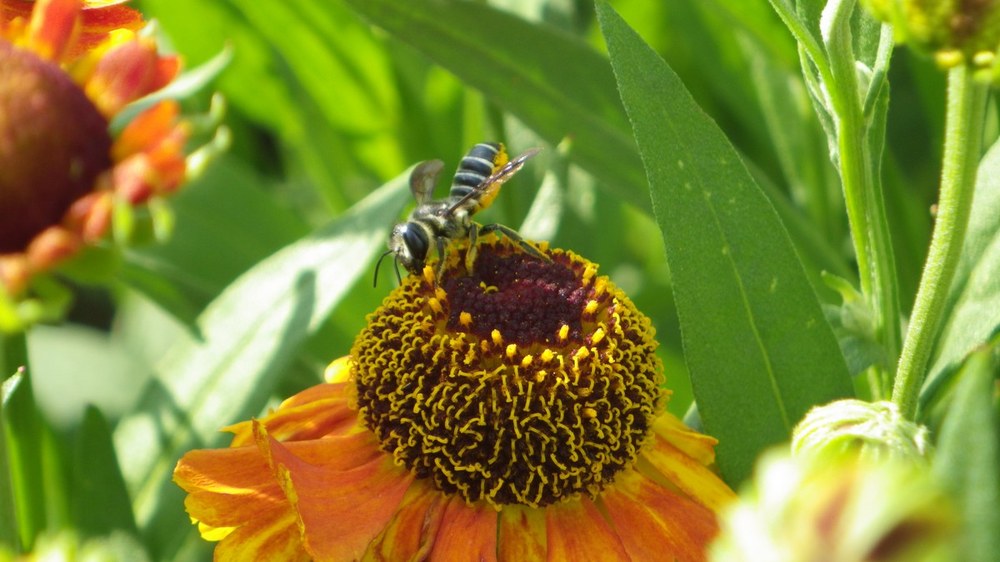Those of us close to the land know that pollinators are essential to life. Bees, butterflies, flies, beetles, birds and others are responsible for pollinating the majority of our world's crops. In fact, pollinators are responsible for about one-third of the food we eat.

Leafcutter bee on Helenium autumnale
Right now pollinators need our help. Most people know that the European honey bee suffers from colony collapse disorder, but fewer are aware that many native pollinators are declining, including bumblebees, one of our best pollinators. The reason for the decline is complex. As more and more land is developed for housing and commerce, we lose plants that are vital sources of nectar and pollen. We also lose places for bees to nest. Diseases and parasites have entered the picture. And lastly, we apply pesticides to our landscapes that are harmful to pollinators. (In a recent study, Penn State researchers found 121 different pesticides in samples of honeybees.)
But the good news is that we all can make a dramatic difference in the future of pollinators. This year, consider making a few changes to your gardening practices and obtain a Pollinator Friendly Garden certification from the Penn State Master Gardeners. It's really quite easy. Start with these simple steps to create friendlier landscapes around homes, farms and workplaces.
- Provide food. Use a wide variety of plants that bloom from early spring into late fall, as pollinators need food throughout the season. When possible, use plants native to your region, because natives have been found to be four times more attractive to pollinators. Include a variety of flower shapes and help pollinators find them by planting in clusters or drifts.
Avoid modern hybrid flowers, especially those with "double" flowers. Often plant breeders have unwittingly left the pollen, nectar and fragrance out of these blossoms while creating the "perfect" blooms for us. Also include larval host plants. If you want colorful butterflies, grow plants that are food for their larvae. The caterpillars will eat them, so place plants where leaf damage can be tolerated.
- Provide a water source. Pollinators need water for drinking and reproduction. If you do not have a natural source on your property, add a bird bath. Mud puddles provide important minerals for pollinators, including butterflies. Try adding a quarter inch of sand to a saucer and add water until the sand is slightly covered. A few flat stones that rise above the water will give access to pollinators.
- Provide shelter. Bumblebees and many solitary bees nest in the ground and need open patches of bare soil. Dead wood provides nesting areas for a variety of pollinators, so leave a snag or place a log in the landscape. Pollinators also need places to overwinter, so instead of cleaning up your gardens in the fall, wait until late spring (except for diseased plant materials, which should be removed and destroyed).
- Safeguard pollinator habitat. Avoid planting invasive species that have escaped cultivation and are endangering plants in our natural areas. Invasive plants include species such as Japanese barberry (Berberis thunbergii), burning bush (Euonymus alatus) and autumn olive (Elaeagnus angustifolia). Even the popular butterfly bush (Buddleia davidii) is considered invasive in areas where it is reseeding along roadsides and trails.
- Reduce pesticide use. Pesticides do not distinguish between pests and pollinators. Using fewer and less toxic pesticides will also protect beneficial insects such as green lacewings, ladybird beetles and others that are your pest control allies. If you must use a pesticide, use the least toxic material possible. Before purchasing, read labels carefully, as many pesticides are especially dangerous for bees. Never spray a blooming plant. And spray after dusk when bees and other pollinators are less active.
When you are ready to apply for certification, go to the Center for Pollinator Research. Follow the steps and fill out the application. Submit it with a $10 nonrefundable fee. If you qualify, you will receive a numbered certificate suitable for framing. You'll also have the opportunity to purchase a beautiful yard sign that will let your friends and neighbors know that you are making a difference for pollinators.

